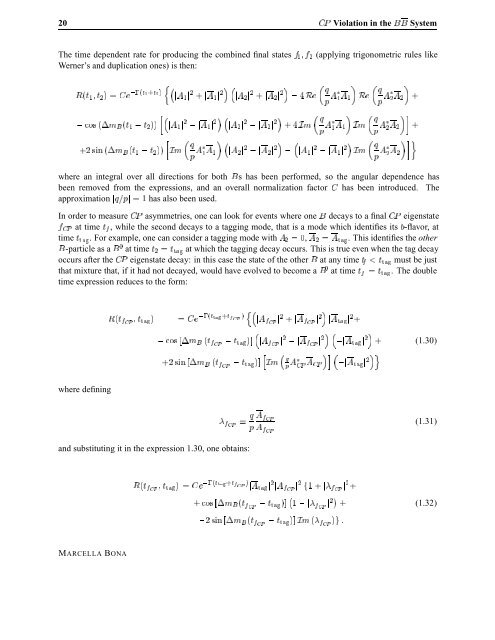Violation in Mixing
Violation in Mixing
Violation in Mixing
Create successful ePaper yourself
Turn your PDF publications into a flip-book with our unique Google optimized e-Paper software.
20 �È <strong>Violation</strong> <strong>in</strong> the �� System<br />
The time dependent rate for produc<strong>in</strong>g the comb<strong>in</strong>ed f<strong>in</strong>al states � �� (apply<strong>in</strong>g trigonometric rules like<br />
Werner’s and duplication ones) is then:<br />
Ê Ø �Ø ���<br />
Ó× ¡Ñ� Ø Ø<br />
Ø Ø<br />
×�Ò ¡Ñ� Ø Ø<br />
�� �� � �� �<br />
�� �� � �� �<br />
� �<br />
Õ<br />
ÁÑ<br />
Ô �£ �<br />
�� �� � �� �<br />
�� �� � �� �<br />
� � �� � �� �<br />
�<br />
�<br />
� �<br />
Õ<br />
��<br />
Ô �£ �<br />
�<br />
Õ<br />
�ÁÑ<br />
Ô �£ �<br />
� �� � �� �<br />
� �<br />
Õ<br />
�<br />
Ô �£ �<br />
� �<br />
Õ<br />
ÁÑ<br />
� ÁÑ<br />
Ô �£ �<br />
� Õ<br />
Ô �£ �<br />
where an <strong>in</strong>tegral over all directions for both �s has been performed, so the angular dependence has<br />
been removed from the expressions, and an overall normalization factor � has been <strong>in</strong>troduced. The<br />
approximation �Õ�Ô� � has also been used.<br />
In order to measure �È asymmetries, one can look for events where one � decays to a f<strong>in</strong>al �È eigenstate<br />
��È at time Ø�, while the second decays to a tagg<strong>in</strong>g mode, that is a mode which identifies its �-flavor, at<br />
time ØØ��. For example, one can consider a tagg<strong>in</strong>g mode with � � , � ��Ø��. This identifies the other<br />
�-particle as a � at time Ø � ØØ�� at which the tagg<strong>in</strong>g decay occurs. This is true even when the tag decay<br />
occurs after the �È eigenstate decay: <strong>in</strong> this case the state of the other � at any time Ø� �ØØ�� must be just<br />
that mixture that, if it had not decayed, would have evolved to become a � at time Ø� � ØØ��. The double<br />
time expression reduces to the form:<br />
where def<strong>in</strong><strong>in</strong>g<br />
Ê Ø��È �ØØ�� � �� ØØ�� Ø� �È<br />
Ó× �¡Ñ� Ø��È ØØ�� ℄<br />
×�Ò �¡Ñ� Ø��È ØØ�� ℄<br />
���È<br />
Ò�<br />
����È � ����È �<br />
Õ<br />
�<br />
Ô<br />
and substitut<strong>in</strong>g it <strong>in</strong> the expression 1.30, one obta<strong>in</strong>s:<br />
MARCELLA BONA<br />
�<br />
����È � ����È� � �<br />
Õ<br />
ÁÑ Ô�£ �È ��È<br />
���È<br />
���È<br />
� �����<br />
�� �����<br />
�� � �����<br />
Ê Ø��È �ØØ�� � �� ØØ�� Ø� ¨<br />
�È ��Ø��� ����È � ����È� Ó× �¡Ñ� Ø��È ØØ��<br />
¡<br />
℄ ����È� ×�Ò �¡Ñ� Ø��È ØØ�� ℄ ÁÑ ���È<br />
� �<br />
�<br />
�Ó<br />
�<br />
��<br />
���<br />
(1.30)<br />
(1.31)<br />
(1.32)















